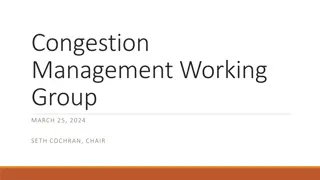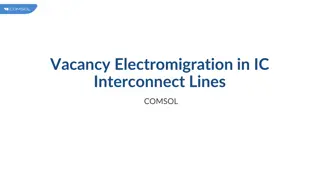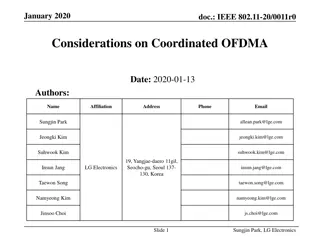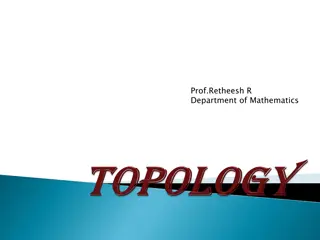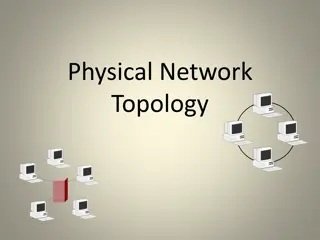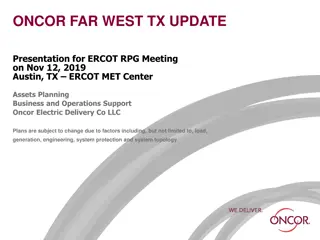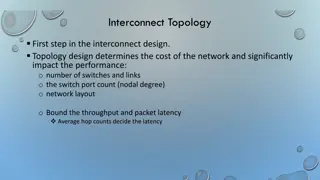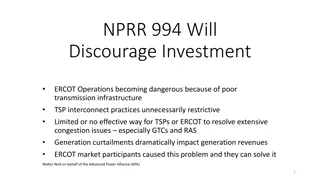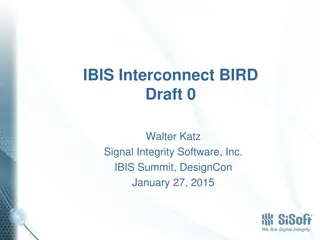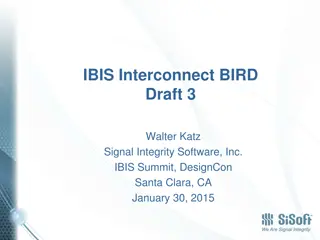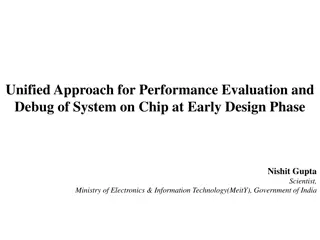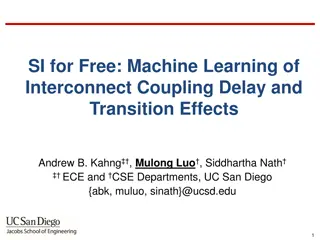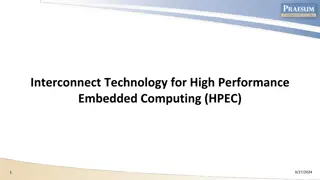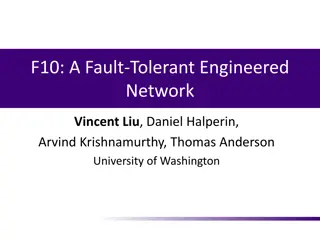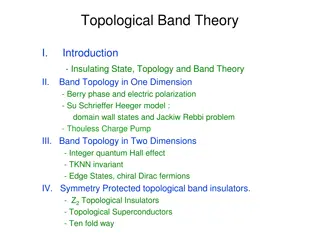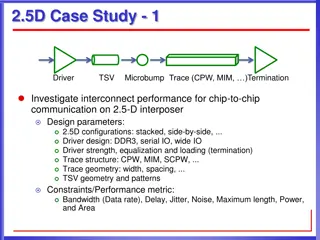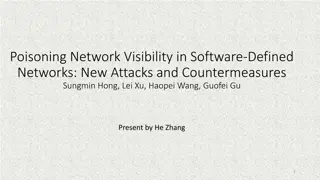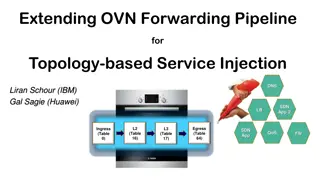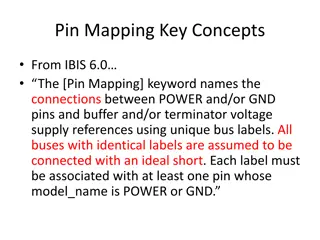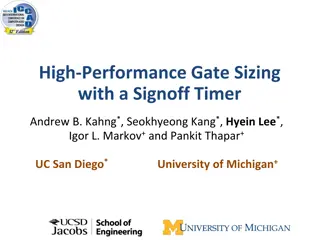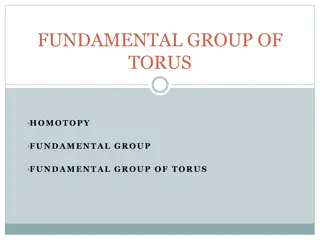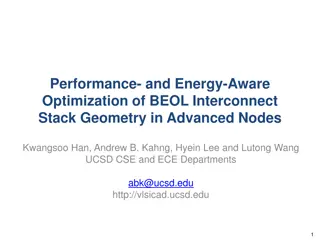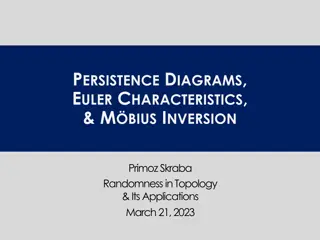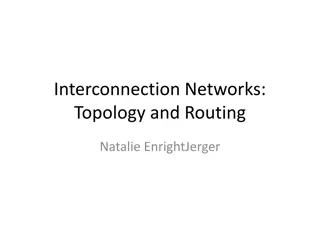Gain Analysis for Coordinated AP Transmissions in IEEE Enterprise R3 Network
This document discusses gain analysis results for coordinated AP transmissions in the IEEE Enterprise R3 network, focusing on tail latency gain for aperiodic traffic. Simulation setups, topology details, and results for different coordination schemes (C-TDMA, C-RTWT, and combined) are provided, show
5 views • 6 slides
Understanding Computer Networks: Basics, Components, and Topologies
Computer networks are essential for sharing resources, exchanging files, and enabling electronic communications. This includes components like senders, receivers, messages, transmission media, and various modes of communication. The need for networking arises from file sharing, resource sharing, com
13 views • 28 slides
Electric Grid Congestion Management Updates
Working Group updates on congestion management strategies including proposed fixes for reliability deployment pricing, mitigations for ESRs, and congestion mitigation using topology reconfigurations. Discussions covered locational price signals, resource payments, offer cap designs, and operational
0 views • 4 slides
Understanding Electromigration Effects in IC Interconnect Lines
Background: As IC circuits advance, preventing failures like electromigration is crucial. Vacancies lead to potential failures in metal interconnects by causing macroscopic voids and hillocks. Explore the governing equations and physics interfaces behind the migration of vacancies in IC circuits. Im
0 views • 14 slides
Understanding Mesh and Star Network Topologies
Network topology plays a crucial role in network performance and maintenance costs. Mesh topology connects every device with a dedicated link, providing reliability and security. On the other hand, star topology connects devices to a central hub, ensuring communication through the hub. Explore the a
0 views • 22 slides
Considerations on Coordinated OFDMA Operation in IEEE 802.11
The document discusses the Coordinated OFDMA (C-OFDMA) operation as a part of Multi-AP coordination schemes within the IEEE 802.11 standard. It covers resource allocation options, topology considerations, resource allocation methods, capability announcement procedures, and negotiation processes betw
0 views • 15 slides
Introduction to Topological Spaces and Examples
Topology is the study of surfaces derived from Greek words meaning surface and discourse. In mathematics, a topological space is a set with a family of subsets satisfying specific properties. Examples include the open ball, open set, indiscrete topology, discrete topology, co-finite topology, and co
0 views • 14 slides
Understanding Physical Network Topologies
Physical network topology refers to the layout of cables, computers, and peripherals in a network, distinct from logical topology. Common physical topologies include Star, Ring, Linear Bus, Tree, and Mesh. Each topology has its advantages and disadvantages, impacting network performance and reliabil
0 views • 16 slides
Understanding IEEE 802.11-20/0410r4 Coordinated Spatial Reuse Procedure
This document presents the Coordinated Spatial Reuse (CSR) procedure in IEEE 802.11-20/0410r4, focusing on the transmission schemes and necessary information for effective spatial reuse. It outlines the topology of CSR environments, acquisition of information for CSR, CSR capability announcement by
8 views • 23 slides
Oncor Far West TX Transmission Projects Overview
This presentation outlines the Oncor Far West Texas transmission projects approved by ERCOT, including planned developments for 2019. The projects aim to enhance the reliability and efficiency of the electrical grid in the region, catering to factors like load, generation, engineering, system protec
0 views • 8 slides
Understanding CMOS Layers and Interconnect Design in Semiconductor Manufacturing
This content provides detailed insights into the CMOS layers, n-well process, p-well process, twin-tub process, metal interconnect layers, gate design, and layout strategies involved in semiconductor manufacturing. Explore the images and descriptions to grasp the complexities of MOS arrays, gate con
0 views • 27 slides
Understanding EIGRP: A Comprehensive Overview
Enhanced Interior Gateway Routing Protocol (EIGRP) is a dynamic routing protocol providing various advantages to network administrators. It is a classless routing protocol supporting VLSM and is considered an Interior Gateway Protocol (IGP). EIGRP uses advanced distance vector routing and is known f
1 views • 5 slides
Understanding Quotient Spaces in Mathematics
In group theory, a subgroup H of a group G helps decompose G into equal-size disjoint subsets called cosets. Quotient spaces in mathematics involve equivalence classes under a given relation and a specific topology. Furthermore, in linear algebra, the quotient of a vector space by a subspace results
0 views • 8 slides
Advancements in Signal Processing for ProtoDUNE Experiment
The team, including Xin Qian, Chao Zhang, and Brett Viren from BNL, leverages past experience in MicroBooNE to outline a comprehensive work plan for signal processing in ProtoDUNE. Their focus includes managing excess noise, addressing non-functional channels, and evolving signal processing techniqu
1 views • 23 slides
SAT-Based Exact Synthesis Using DAG Topology Families
Explore the world of exact synthesis in digital circuit design utilizing SAT solvers to achieve precise results. Understand the challenges, decision problems, algorithms, motivation behind exact synthesis, and the contribution of SAT solvers in mitigating runtime. Discover the concept of DAG topolog
0 views • 17 slides
Understanding Interconnect Topology Design and Performance Metrics
Interconnect topology design plays a crucial role in determining the cost and performance of a network. Factors such as the number of switches and links, switch port count, network layout, throughput, packet latency, average hop counts, nodal degree, hop count, and diameter are essential considerati
0 views • 38 slides
Understanding Interconnection Networks Topology
Exploring the topology of interconnection networks helps determine the arrangement of channels and nodes, impacting network cost, performance, latency, energy consumption, and complexity of implementation. Abstract metrics such as degree, hop count, and network diameter play crucial roles in evaluat
1 views • 56 slides
Challenges in ERCOT Transmission Infrastructure & Operations
Poor transmission infrastructure and restrictive interconnect practices in ERCOT are leading to dangerous operations, congestion issues, and generation revenue impacts. Concerns include increased RAS proposals, challenges with GTC management, and minimalist interconnect processes. The need for impro
0 views • 9 slides
Overview of Carrier Price List and Country Groupings
The Carrier Price List outlines rates exclusive of taxes, covering defined services. Countries are grouped into zones, affecting interconnect rates. The list includes Zone 1 (Belgium, EU, EFTA, China, India) and subsequent groups. Orange BE may adjust country zoning.
0 views • 8 slides
IBIS Interconnect: Models and Task Group Overview
The IBIS Interconnect draft explores models representing package and on-die interconnect, with separate or combined approaches for on-die, package, supply, and signal interconnect. The IBIS Interconnect Task Group, comprising major contributors such as Altera, Cadence Design Systems, Intel Corp, and
0 views • 10 slides
Overview of IBIS Interconnect Task Group Models
The IBIS Interconnect Task Group focuses on modeling package and on-die interconnects, with support for separate or combined interconnect models. They meet weekly to discuss contributions from major companies like Altera, Cadence, Intel, and more. The models include terminals for differential signal
0 views • 17 slides
Understanding Net Metering with FPUA Fort Pierce Utilities Authority
Net metering enables customers to own or lease renewable generation, interconnect with the electric system, and offset consumption. Customers can use solar energy in their homes and the excess energy generated can be sold back to the grid. The rate utilities pay for excess generation varies and is s
0 views • 11 slides
Unified Approach for Performance Evaluation and Debug of System on Chip in Early Design Phase
This presentation discusses the challenges related to system-on-chip design, focusing on bandwidth issues, interconnect design, and DDR efficiency tuning. It explores the evolution of performance evaluation methods and the limitations of existing solutions. The need for a unified approach for early-
0 views • 28 slides
Machine Learning of Interconnect Coupling Delay and Transition Effects
This research paper explores the use of machine learning to study interconnect coupling delay and transition effects in VLSI design. It discusses the challenges of calibrating non-SI to SI timing reports, the impact of clock period adjustments on path slack, and the complexities involved in the cali
0 views • 32 slides
Understanding Cache Coherency and Multi-Core Programming
Explore the intricate world of cache coherency and multi-core programming through images and descriptions covering topics such as how cache shares data between cores, maintaining data consistency, CPU architecture, memory caching, MESI protocol, and interconnect bus communication.
0 views • 97 slides
Cutting-Edge Interconnect Technology for High-Performance Computing
Explore the world of high-performance embedded computing through images and descriptions detailing key components like terrestrial autonomous vehicles, wireless infrastructure, FPGA-based data exchange, and more. The content dives into fault tolerance, data processing, redundant computing, and hardw
0 views • 12 slides
Fault-Tolerant Engineered Networks Overview
Explore the design and challenges of fault-tolerant engineered networks such as FatTrees, with a focus on recovery strategies, topology innovations, and failure detection mechanisms. Learn about the co-design of topology, routing protocols, and failure detectors for optimal performance in data cente
0 views • 27 slides
Exploring Topological Band Theory and Quantum Phases in Electronic Matter
Delve into the fascinating realm of topological band theory, examining the insulating state, band topology in different dimensions, symmetry-protected topological band insulators, and the interplay between symmetry and topology. Uncover the principles underlying matter symmetry, quantum phases, and
0 views • 29 slides
Optimizing Multi-Party Video Conferencing through Server Selection and Topology Control
This paper proposes innovative methods for multi-server placement and topology control in multi-party video conferences. It introduces a three-step procedure to minimize end-to-end delays between client pairs using D-Grouping and convex optimization. The study demonstrates how combining D-Grouping,
0 views • 13 slides
Investigating Chip-to-Chip Communication Performance on 2.5D Interposer
Investigate the performance of chip-to-chip communication on a 2.5D interposer by analyzing interconnect parameters such as configurations, driver design, trace structure, TSV geometry, and channel modeling. Explore methods like SPICE simulation and MATLAB GUI for performance estimation and optimiza
0 views • 18 slides
Understanding Software-Defined Networking (SDN) Threats and Countermeasures
Software-Defined Networking (SDN) revolutionizes network management by separating control and data planes, providing flexibility, and enabling innovative flow handling. This presentation explores SDN concepts, OpenFlow protocol, operational distinctions from legacy networks, and the importance of to
0 views • 27 slides
Extending OVN Forwarding Pipeline for Topology-based Service Injection
Explore how to extend the OVN forwarding pipeline to enable topology-based service injection, allowing external applications to influence flow routes dynamically, such as for service chaining and DPI. The extensible pipeline facilitates the interaction with base OpenFlow pipelines, distributed netwo
0 views • 17 slides
Understanding Pin Mapping and Interconnect in IBIS 6.0
Pin Mapping in IBIS 6.0 defines the connections between POWER/GND pins and buffer/terminator voltage supplies using unique bus labels. Interconnects between VDD pins and buffer supply terminals are crucial, with all pins associated with a named supply being shorted together. Draft 9 Interconnects an
0 views • 6 slides
InterConnect A/S - Driving Innovation in Legal Technology
InterConnect A/S, established in 1996 in Svendborg, Denmark, specializes in software development and ERP/database systems. As a key player in the LIT Pilot Project, they are actively involved in developing a search machine for legal interpreters and translators. With a strong track record in project
0 views • 16 slides
High-Performance Gate Sizing with Signoff Timer: VLSI Design Challenges
This study delves into the intricate realm of gate sizing in VLSI design, focusing on optimizing power and delay through effective approaches and addressing challenges such as interconnect delay, inaccurate internal timers, and critical paths. Previous gate sizing techniques are evaluated, and a met
0 views • 34 slides
Understanding Homotopy and Fundamental Groups in Topology
Explore the concepts of homotopy and fundamental groups in topology, where objects with the same structure can be classified into classes, and the fundamental group characterizes loops. Discover the fundamental group of a torus, its identity elements, closure, associativity, and inverses. Homotopy a
0 views • 10 slides
Understanding the Impact of Crooked Traceroute on Network Topologies
Traceroute-based algorithms play a crucial role in collecting network topology data, but the introduction of per-flow load balancing has raised concerns about the accuracy of these algorithms. This study examines the implications of crooked traceroute on false link inference rates and the identifica
0 views • 23 slides
Energy-Aware Optimization of BEOL Interconnect Stack Geometry
This study focuses on optimizing Back-End-of-Line (BEOL) interconnect stack geometry in advanced nodes for improved performance and energy efficiency. It explores the motivations, background, and potential benefits of Design-Aware Manufacturing (DAM) and Manufacturing-Aware Design (MAD) methodologie
0 views • 28 slides
Randomness in Topology: Persistence Diagrams, Euler Characteristics, and Möbius Inversion
Exploring the concept of randomness in topology, this work delves into the fascinating realms of persistence diagrams, Euler characteristics, and Möbius inversion. Jointly presented with Amit Patel, the study uncovers the vast generalization of Möbius inversion as a principle of inclusion-exclusio
0 views • 57 slides
Understanding Interconnection Networks: Topology and Routing
Interconnection networks play a crucial role in determining the arrangement of channels and nodes within a network, similar to a road map guiding traffic flow. Topology overview defines the network structure, while abstract metrics help evaluate performance and cost. Latency and throughput are key f
0 views • 49 slides


